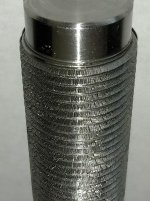Somewhere's on the innertube there's videos showing how a carbide tool removes metal VS how a HSS bit shears it like a knife.
When I see that look, which I call "pulling" it's a sure sign need to ramp the speed up.....'WAYYYYY up. Or dig in deeper and crank up the coolant. Or both.
Which I generally cannot do.
Two of my sons are engineers and when I talk about "feeds and speeds and what I'm fighting on my lathe" .......... they look at me as if I'm from another planet

I talk in "ten's" and "hundreds" of rpm's and surface speed, they talk in thousands.... And the stuff they machine, and the way they machine it is literally beyond the capabilities of my manual equipment. I'm personally just now getting back in touch with the equipment enough to know when to say "ooops! this ain't working!" and radically change something, like try a different material

Lathe I'm pretty good, Bridgeport is still day by day.
I will say this, In My Opinion that surface finish is a sure sign of "call it a day, this IS NOT a settings issue but instead a bad mix of materials"
For ME
In other words that's what I would do.

Because I don't know no better





